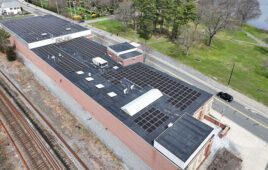
Thanks to use of gallium-nitride power semiconductors, the Yaskawa Enewell-SOL V1 series PV inverter is about 40% smaller than its predecessor. The two inverters are shown here for comparison.
The next generation of solar inverters could squeeze into smaller spaces and be more efficient than those available today. An indication of the trend arose recently with a development by Yaskawa Electric Corp., which it bills as the world’s smallest power conditioner in its class.
The inverter has about 60% of the volume of competing devices, according to Yaskawa, which also owns U.S. commercial PV inverter manufacturer Solectria. The compact packaging comes mainly from the use of a gallium nitride (GaN) power module in the inversion circuitry, rather than conventional power semiconductors based on silicon. The Yaskawa inverter is said to be the first commercial solar inverter to employ GaN.
The GaN semiconductor devices operate at three times higher switching frequencies than silicon-based modules. The higher frequencies allow the inverter electronics to use smaller magnetics and heat sinks than conventional inverters. Yaskawa said the 4.5-kW indoor PV inverter, the Enewell-SOL V1 series, will be distributed in Japan, at least initially. Yaskawa also said it will consider releasing the inverters in other countries later on.
Though GaN has long been used in light-emitting diodes and microwave circuitry, it has only recently come to mainstream power conversion electronics. In 2010 the first enhancement-mode GaN transistors became generally available. These devices are designed to replace silicon power devices in applications where switching speed or power conversion efficiency is important. Because GaN transistors can operate at much higher temperatures and work at much higher voltages than transistors made with several alternative technologies, they make good power amplifiers.

The Yaskawa Enewell-SOL V1 series PV inverter uses a boost converter driving a half-bridge composed of gallium-nitride power transistors, as depicted in a simplified circuit schematic.
In the Yaskawa inverter, GaN semiconductors bring other benefits, including an overall peak efficiency above 98% and an ability to operate without the need for cooling fans. The GaN semiconductors are made by Transphorm in Goleta, Calif., a firm founded in 2011 and backed by investors including Google Ventures. The Transphorm power module is dubbed the TPD3215M and was developed specifically for use in the Yaskawa inverter. According to a Yaskawa spokesperson, the GaN module incorporates a normally-off, low-voltage silicon transistor at the input and a normally-on, high-voltage GaN HEMT (high-electron mobility transistor) at the output.
Yaskawa said the inverter uses a conventional circuit topology consisting of a boost circuit and an H bridge, but this circuitry is optimized for the GaN device. And it looks as though more powerful inverters will soon employ GaN power devices as well.
Yaskawa said it has plans to develop and launch an inverter employing GaN modules with a higher power output next year. However, only smaller inverters will likely benefit from GaN in the near future. Yaskawa said the amount of electrical current GaN switching devices can handle limits them to use in applications of 6 kW or less, though future generations of these devices are expected to have better power-handling capabilities.





Tell Us What You Think!